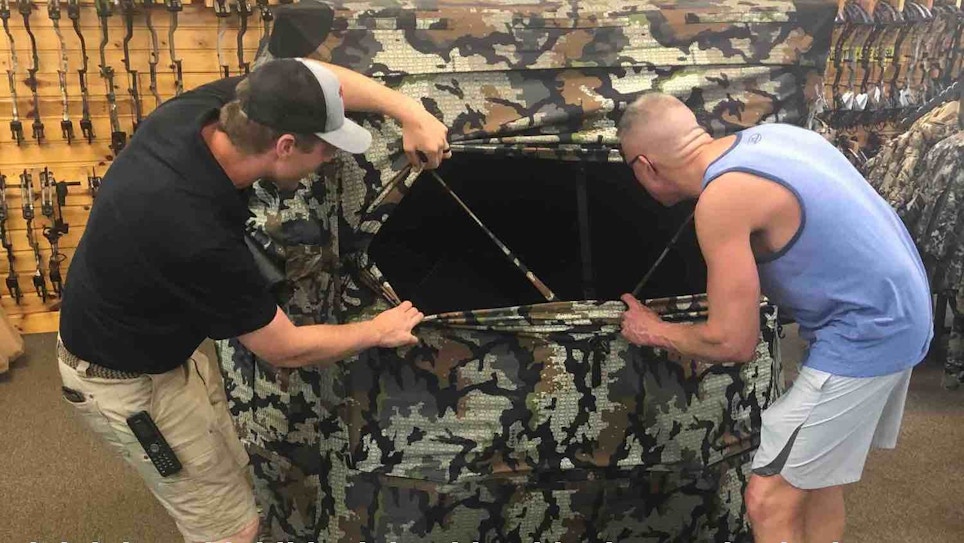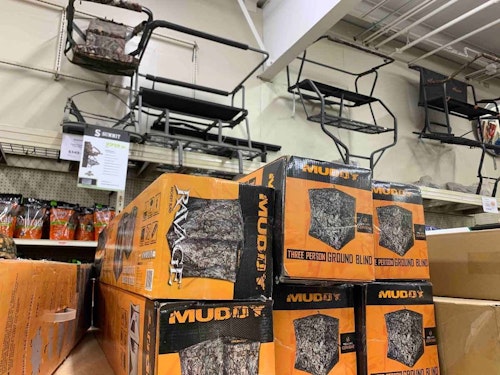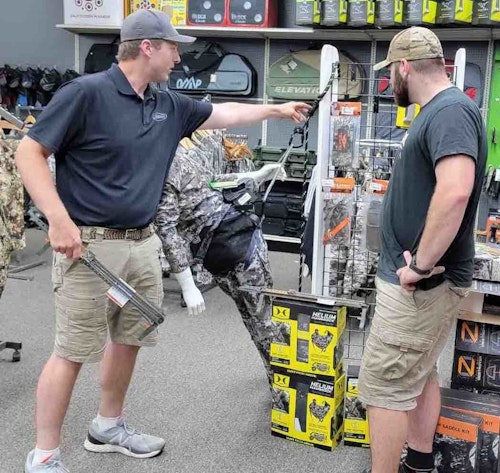
When you have a pop-up ground blind displayed so customers can see it and step inside, you’ll have an easier time of selling it because you can illustrate all of the product details and key features. (Photo by Darron McDougal)
It’s no secret that small retailers climb a steep mountain by committing to sell treestands and ground blinds in their archery pro shops. Let’s face it: Box stores and chain retailers command the buying-power food chain. Often, volume retailers get the best per-unit pricing, and in turn, they can sell each unit to consumers at a lower price than can a small archery dealer. That combined with freight can practically eat small dealers alive.
Add to that the fact you can find treestands and ground blinds nearly anywhere — including some hardware and building-supply stores — and it’s no wonder some archery pro shops elect not to fuss with these categories. However you slice it, box stores and chain retailers have the upper hands. Still, wouldn’t it be nice to say “Yes!” when a customer asks if you sell treestands and ground blinds? In other words, why lose the sale to another store when you can make it?
Unfortunately, some small archery dealers set off on the wrong foot. They make the mistake of trying to compete with box stores by offering the same poor-quality treestands and ground blinds that you’d find at large sporting goods or hardware stores. Do this, and you’ll probably sell some here and there, but not nearly enough to make the operation worthwhile. Plus, do you really want to hang your “pro shop” name on cheap merchandise? Maintaining quality standards is crucial in treestands and ground blinds, just like it is in bows and arrows.
If you want to offer treestands and ground blinds, and have success with selling them despite fierce competition, I have some input to help you. Recently, I connected with Brandon Looman of Archery Country in Waite Park, Minnesota. Archery Country has been doing quite well with selling products in these categories, and Looman and I discussed what treestand and ground blind sales look like at Archery Country. The following paragraphs highlight tips from our discussion that can help you make sound decisions for your pro shop. Let’s review.
Offer Unique Lines
As I mentioned earlier, offering poor-quality blinds and treestands positions your store as a “me, too.” In other words, you’re offering stuff folks can purchase virtually anywhere blinds and stands are sold. Instead, look for products with better margins that your local competitors don’t sell, and you’ll likely realize some worthwhile benefits in these offering and selling product categories.
“Margin is obviously a factor in our purchasing decisions,” Looman said. “But, we bring in products that we use and believe in ourselves. Not everyone in the store has to use it, but at least a handful of our full-time employees must use an item before we stock it. We always find that items are easier to sell when we’re excited about selling them. Knowing the product and having history with it better positions you to sell it to your customers.”
As I did earlier, Looman also cautioned against cheap products.
“In the past, we dabbled in lower-priced stands and blinds,” he said. “Of course, we found we couldn’t compete with the large box stores and chain retailers on the cheap stuff. There’s a small margin to begin with, and then when other stores run sales or discounts, you just get beat up too badly. Plus, if someone is shopping for a $50 treestand or a $100 ground blind, they’re not usually looking at pro shops anyway. They’re going to the larger retailers that have three or more options in that low price range. Trying to compete with the larger retailers is a losing battle.
“For that reason, we focus on the high-end stuff. If you’re going to sell any number of stands or blinds at all, it will generally be at the higher end. Customers look to pro shops for higher priced, higher quality items. They’re also likely to shop in that category at a store staffed with folks who know what they’re talking about, and have the expertise versus talking to someone who doesn’t use the product or doesn’t hunt at all.”
Looman also briefly touched on some insights regarding a healthy number of lines that a pro shop should consider carrying. He suggested not diving in too deep.
“Under normal circumstances,” he began, “we usually carry two different brands of ground blinds. Within those two brands, we usually stock one or two models. That gives our customers some options, but we’re not left with a bunch of them following hunting season. Treestands aren’t much different. We usually stick with one or two brands and just a handful of models in each.
“Of course, just like everybody else, we’re having issues with getting anything in. So this year, we have just one ground blind brand and two models. With treestands, we were really only able to get one brand, but we have about five models available. Before all of the chaos hit, our offerings were as I described earlier.”
Beyond that, look for products with unique features. This can set you apart from competitors. Further, buy from brands that have top-tier customer service. High-end consumers seek quality brands that stand behind their products.

Displays and Selling
It goes without saying that treestands and ground blinds take up lots of space, so how do you display them effectively without filling your entire store? Looman offered some suggestions that have worked for Archery Country.
“Our retail floor isn’t huge,” he said, “so we’ve set up logs vertically in order to display our treestands where our customers can easily see them. Sometimes, box stores use similar displays, but in a lot of cases, the treestands are in just their boxes. That limits the customer’s ability to see and touch the product. With our display, we can show them how the straps work and how the platform adjusts. They can even sit in it to see how the seat feels. The ability to see and touch makes customers more decisive.
“We do that with ground blinds, too. We display them so we can show the customer exactly how the windows work, how they set up and how they collapse. We’ll jump right inside the blind with the customer and run through all of the details. That really improves our ability to sell blinds. Most box stores aren’t staffed with professional help. Our customers really benefit from having someone versed in the product category to explain and illustrate everything.”
As for back stock, Archery Country is fortunate enough to have three store locations plus some warehousing capability. Looman admitted that the warehousing space is a bit more “advantageous,” as he put it, as compared to a small shop with no storage or warehouse. That being said, each Archery Country store location might have 12 treestands or so on hand during the hot selling season, but with the ability to replenish from the warehouse, when needed.
Treestands and ground blinds primarily sell at key times of the year, and you can use your limited retail space for other items during the offseason.
“About a month before spring turkey season, we’ll set up a ground blind or two,” Looman said. “We leave them up until toward the end of turkey season. Then, we take them down until around the first of August when we expect our customers will be preparing for deer season. So, we have the ground blinds displayed in our store for only about 4 months of the year.
“Treestands also have a narrow selling window. We have our shipments programmed to arrive in June. The majority of them sell between August 1 and October 1. Beyond that, we occasionally sell one here and there throughout the year, but very few compared to the aforementioned timeframe. We try to sell through them each year, but if any are left, all but one or two are typically returned to the warehouse.”
Find Ways to Save
Treestands and ground blinds share a common profit-eating denominator: freight. Consider: A $300 bowsight ships in a small package and weighs usually a pound or less. In contrast, a $300 treestand might weigh 12 pounds and ship in a box many times larger than the bowsight box. That’s why it’s important to save money where you can. Joining a buying group and also attending the ATA Show makes great sense for small dealers selling these bulky products.
“Our owner goes to the Sports, Inc. and ATA Shows to take advantage of deals and specials,” Looman shared. “A big one is free freight on large orders. We talk a lot beforehand and try to land on some order quantities. We estimate how many we think we’ll sell during the year, and then he programs the orders to arrive at appointed times.
“Whatever we get from these orders is it for us for the year. It’s a gamble. If we sell out, well, we should’ve ordered heavier. Freight is too high to order some now, some later and so on. Freight will crush you. Plus, the price per item outside of the trade shows is typically higher. Every once in a while, we’ll special-order a stand or blind, and some customers are willing to pay the shipping, but those are the exceptions. The best bet is to estimate what you’ll sell for the year and order it at discounted pricing at the buying shows.”

Dive In or Test the Waters?
If you’re in a location where folks hunt from treestands and ground blinds, then you should do very well with these categories. But, if you’re in an area where these hunting tools are less popular, or if you’re simply unsure how customers will respond to them, take baby steps. If that means bringing in six units of one treestand model and three units of one ground blind model, so be it. Start small, measure your success and be attentive to what works well and what doesn’t.
There is money to be made by selling treestands and ground blinds, so don’t overlook these categories. Follow the principles outlined in the article, especially by selling what you personally use and believe in. That should serve you well in selling these tough product categories.

Sidebar: Selling Saddles
Another way to capitalize on sales is by taking on the related category of saddles. Brandon Looman of Archery Country in Waite Park, Minnesota, says the category is popular and is even easier than treestands to manage.
“Last year we became a Tethrd dealer,” Looman said. “We’re also a Hawk Hunting dealer and had brought in some of the brand’s saddles a year prior to signing up with Tethrd. Once we got on board with Tethrd, however, our saddle sales caught fire. The saddle market is growing and generating lots of interest. Personally, I’ve been saddle hunting for 20 years, so it’s a natural fit for me to talk about it with customers. The other employees have saddles, too. When someone comes in with questions, we have answers for them. That’s important.
“There are reasons beyond popularity to offer saddles. First, since they’re smaller than treestands, you’ll save on shipping. They also consume less floor space. That makes it an easier item to carry for the really small archery shops.
“Do I see saddles surpassing treestand sales anytime soon? No. In my opinion, they aren’t quite as comfortable as treestands. Customers with bad backs or knees will probably purchase treestands instead. But, in the next 5-10 years, it wouldn’t surprise me if saddle sales are much higher than they are today.”
Click here to read an article from Archery Business Editor Dave Maas titled, "Saddles: Why You Should Display and Sell Them."





